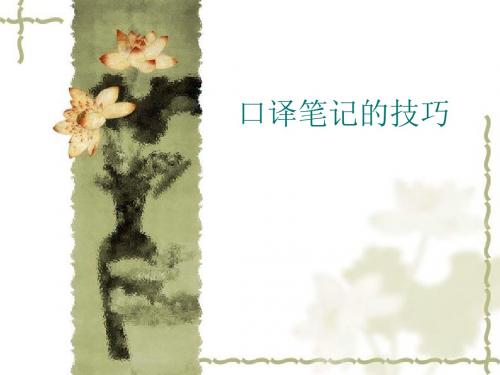英语口译笔记技巧 PPT课件
合集下载
口译笔记技巧 课件

阶梯式排列
条列式记法
LANGUAGE
• During the process of interpreting, we can use the language we know well, abbreviations or ideograms to help us take notes. (more details on textbook P60-61) • Firstly, it is good to get to know the topic or if possible the copy material prior to the work in order not to be new with the content of the utterance. In addition, practicing taking note in separated and logical form is well recommended to avoid all confusion when reading back notes. And notes using abbreviations and symbols are very helpful in activating the most information in limited time with the least effort. • for example, International Monetary Fund (IMF) or International Criminal Police Organization (INTERPOL). • Besides, some symbols are also useful such as,. increase↑, decease ↓, etc
英汉翻译口译记忆方法ppt课件

记忆中信息检索和提取的速度和可能性取决 于记忆的激活程度,而激活程度又取决于记忆使 用的频率和使用的新近程度。换言之,联系越多, 练习的时间越近,信息提取速度就越快。
14
口译记忆的原则
口译记忆的关键在于两个环节:存储和提取。 首先,我们要在听辨理解中注意提取源语语篇的意义,而 不是试图对源语的字词进行机械记忆。 其次,要有意识地筛选记忆的对象,以缩小记忆量。记忆 对象主要包括:主题词、关键词和逻辑线索,三者结合起来构 成了语篇的框架。 再次,应该理清记忆的线索并扩大记忆的容量,提高记忆 效率
Despite that
Though
并列关系
And
Also
As well as
Either…,or…
递进关系
Moreover Besides
In addition Further
Not only…, but also… Still
Even
比较关系
Apart from
…rather than…
Compared with
8
练习3:
联合国安理会16日发表声明,强烈谴责朝鲜4月 13日进行的卫星发射。声明要求朝鲜立即全面遵守安 理会第1718号和1874号决议,不使用弹道导弹技术进 行进一步发射,不进行核试验。
朝鲜外务省则在声明中强调,朝鲜本次发射卫 星保持了最大限度地真诚和透明,但美国非要给朝鲜 扣上发射远程导弹的帽子,并将制裁朝鲜的无理要求 强加给了联合国安理会。这是对朝鲜民族尊严和主权 的侵害。
19
口译笔记记什么
• Layout of a paragraph:
topic sentence + details/examples/supporting ideas/facts
14
口译记忆的原则
口译记忆的关键在于两个环节:存储和提取。 首先,我们要在听辨理解中注意提取源语语篇的意义,而 不是试图对源语的字词进行机械记忆。 其次,要有意识地筛选记忆的对象,以缩小记忆量。记忆 对象主要包括:主题词、关键词和逻辑线索,三者结合起来构 成了语篇的框架。 再次,应该理清记忆的线索并扩大记忆的容量,提高记忆 效率
Despite that
Though
并列关系
And
Also
As well as
Either…,or…
递进关系
Moreover Besides
In addition Further
Not only…, but also… Still
Even
比较关系
Apart from
…rather than…
Compared with
8
练习3:
联合国安理会16日发表声明,强烈谴责朝鲜4月 13日进行的卫星发射。声明要求朝鲜立即全面遵守安 理会第1718号和1874号决议,不使用弹道导弹技术进 行进一步发射,不进行核试验。
朝鲜外务省则在声明中强调,朝鲜本次发射卫 星保持了最大限度地真诚和透明,但美国非要给朝鲜 扣上发射远程导弹的帽子,并将制裁朝鲜的无理要求 强加给了联合国安理会。这是对朝鲜民族尊严和主权 的侵害。
19
口译笔记记什么
• Layout of a paragraph:
topic sentence + details/examples/supporting ideas/facts
英语口译听力速记技巧ppt课件

• ↓表示“下降、减少、急剧下降、急速下 跌等”;
• ↗表示“缓慢上升,缓慢发展、缓慢上涨 等”;
•
• ←表示“返回,倒退等”; • →表示“达到,至,导致,前进等”;
• +表示“加,增加,此外,另外,又加 之”;
• —表示“减少,减”;
>表示“多于,大于,强于”; <表示“少于,小于,不如”; ∵表示“因为,由于”; ∴表示“所以,因此”;
°表示人
Chinese C °
Americans A °
°
Japanese J °
Scientists Sci °
Technician Tech °
以上是一些通行的的原则。通行的原则 存在,通行的方式却不存在,这是因为 每个人的对记录符号的使用可能是多样 的,同一事物不同的人可能会使用不同 的符ቤተ መጻሕፍቲ ባይዱ,同一符号在不同的人意识中肯 能代表不同的意思。
• ~大约,如: approximately , about , around , some , nearly , almost ,
similar to…
/否定,清除,如: clear , settle , solve , tackle , conquer , eliminate , extinct…
1、不要大量记录文字(汉字、单词)
——而要使用符号来表示意思(缩写、图形) Eg:“powerful country”记作“强
口”, “我同意”记作“I√ ”; “观点,看法一致”记作“⊙ same”, “economic development”记作“经↑”
• ↑表示“上升、快速上升、快速发展、快 速上涨等”
concerned( 就 …… 而言 ) LFT : look forward to ( 期待 ) ASAP : as soon as possible( 尽快 )
• ↗表示“缓慢上升,缓慢发展、缓慢上涨 等”;
•
• ←表示“返回,倒退等”; • →表示“达到,至,导致,前进等”;
• +表示“加,增加,此外,另外,又加 之”;
• —表示“减少,减”;
>表示“多于,大于,强于”; <表示“少于,小于,不如”; ∵表示“因为,由于”; ∴表示“所以,因此”;
°表示人
Chinese C °
Americans A °
°
Japanese J °
Scientists Sci °
Technician Tech °
以上是一些通行的的原则。通行的原则 存在,通行的方式却不存在,这是因为 每个人的对记录符号的使用可能是多样 的,同一事物不同的人可能会使用不同 的符ቤተ መጻሕፍቲ ባይዱ,同一符号在不同的人意识中肯 能代表不同的意思。
• ~大约,如: approximately , about , around , some , nearly , almost ,
similar to…
/否定,清除,如: clear , settle , solve , tackle , conquer , eliminate , extinct…
1、不要大量记录文字(汉字、单词)
——而要使用符号来表示意思(缩写、图形) Eg:“powerful country”记作“强
口”, “我同意”记作“I√ ”; “观点,看法一致”记作“⊙ same”, “economic development”记作“经↑”
• ↑表示“上升、快速上升、快速发展、快 速上涨等”
concerned( 就 …… 而言 ) LFT : look forward to ( 期待 ) ASAP : as soon as possible( 尽快 )
口译笔记-PPT

口译记录的重要性
一、口译记录可以减轻大脑的负担,弥补译员短时记忆的不足。 对来源语内容的完全吸收和用目的语迅速、准确、完整的表达需要译员将注意力高度集中起来。 二、口译记录有助于将被动记忆转化为主动记忆。 译员使用一种“提醒物”,他就可以借助于这种“提醒物”,轻松地将被动记亿全部转换为主动记忆。即席口译时记录的作用就在于此。
口译记录符号分类
10、指示过去、现在和将来的符号 :用一个小圆点来解决,小圆点在不同的位置便表示不同的时间概念。 e.g:用“Y”表示“今年”,那么“去年”则可以记作“.Y”,而“三年后”便可以记着“3Y.”。其它一些时间单位像分、秒、小时、日、周、月、世纪等的记录方式都可以如法炮制。 11、缩略词 :缩略词一般用于对国名、地名或组织机构等的简化,广泛应用于新闻报道、电报、电传之类的文体中 e.g: “中国人民政治协商会议(Chinese People's Political Consultative Conference)”和“北美自由贸易区(North American Free Trade Area)”在英语中便分别简化成了“CPPCC”和“NAFTA”。
口译记录符号分类
每个人都可以有自己的记录符号系统 简洁、高效、不要求别人识读
记什么?1ຫໍສະໝຸດ 句子架构: 即来源语的架构和主从句的逻辑关系。高手也可以直接记成目标语的架构。 2、信息点:句子都是通过架构的逻辑关系把意群串起来的。 3、细节:如数字、年份等。
怎么记?
1、用源语记:学会连写和快写 2、用目标语记:学会一心两用(同步过程需专门训练) 3、用自己熟悉的符号记:如缩写、图标或自创的符号。 4、理解为上:开始阶段多记为上,熟练以后少记为上。
口译记录符号分类
5、印刷符号 : e.g: “∧”则表示“插入”、“干涉”、“介入”、“侵略”,而“/”则用来表示“删(剔)除”、“取消” 6、数学符号 : 加号“+”可以表示 “增加”、“补充”;“减号”“-”则表示“扣除”“减少”,而“≈”便用来表示“大约”、“几乎”;“∵”则可以表示“由于”“因为”等概念。
一、口译记录可以减轻大脑的负担,弥补译员短时记忆的不足。 对来源语内容的完全吸收和用目的语迅速、准确、完整的表达需要译员将注意力高度集中起来。 二、口译记录有助于将被动记忆转化为主动记忆。 译员使用一种“提醒物”,他就可以借助于这种“提醒物”,轻松地将被动记亿全部转换为主动记忆。即席口译时记录的作用就在于此。
口译记录符号分类
10、指示过去、现在和将来的符号 :用一个小圆点来解决,小圆点在不同的位置便表示不同的时间概念。 e.g:用“Y”表示“今年”,那么“去年”则可以记作“.Y”,而“三年后”便可以记着“3Y.”。其它一些时间单位像分、秒、小时、日、周、月、世纪等的记录方式都可以如法炮制。 11、缩略词 :缩略词一般用于对国名、地名或组织机构等的简化,广泛应用于新闻报道、电报、电传之类的文体中 e.g: “中国人民政治协商会议(Chinese People's Political Consultative Conference)”和“北美自由贸易区(North American Free Trade Area)”在英语中便分别简化成了“CPPCC”和“NAFTA”。
口译记录符号分类
每个人都可以有自己的记录符号系统 简洁、高效、不要求别人识读
记什么?1ຫໍສະໝຸດ 句子架构: 即来源语的架构和主从句的逻辑关系。高手也可以直接记成目标语的架构。 2、信息点:句子都是通过架构的逻辑关系把意群串起来的。 3、细节:如数字、年份等。
怎么记?
1、用源语记:学会连写和快写 2、用目标语记:学会一心两用(同步过程需专门训练) 3、用自己熟悉的符号记:如缩写、图标或自创的符号。 4、理解为上:开始阶段多记为上,熟练以后少记为上。
口译记录符号分类
5、印刷符号 : e.g: “∧”则表示“插入”、“干涉”、“介入”、“侵略”,而“/”则用来表示“删(剔)除”、“取消” 6、数学符号 : 加号“+”可以表示 “增加”、“补充”;“减号”“-”则表示“扣除”“减少”,而“≈”便用来表示“大约”、“几乎”;“∵”则可以表示“由于”“因为”等概念。
【最新】英语口译听力速记技巧ppt课件

都有这样的经历,听的时候大意可以听懂,但
是由于听时未作任何速记,关键词汇,逻辑关
系在听后无法正确归纳,导致最后只能译出第
一句或最后一句,而中间部分则完全忽略或遗
忘。真是如此,你是不可能通过口译考试的。
因此,自己在平日练习时一定要把速记归入计
划之内。 30
2021/2/2
• 现列举一个段落来进行一下速记的说明:
26
2021/2/2
.表时间前后,如去年. y ,明年 y .,后 天 d ..,前天.. d ,两周后 w ..
Americans A °
°
Japanese J °
Scientists Sci °
Technician Tech °
28
2021/2/2
以上是一些通行的的原则。通行的原则 存在,通行的方式却不存在,这是因为 每个人的对记录符号的使用可能是多样 的,同一事物不同的人可能会使用不同 的符号,同一符号在不同的人意识中肯 能代表不同的意思。
29
2021/2/2
口译考试之所以难,在于其长度和规定的限
时。估计很多参加过第二阶段口译考试的考生
投 校
院
学
图
社
10
2021/2/2
3、逻辑关系要清楚明了
——不要记流水帐。
11
2021/2/2
常见记录方式
A 。保留大写字母或第一音节 经济: E 教育: Edu 文化: C 政治: P
12
2021/2/2
科技: ST 卫生: H 旅游: T 环境: En 工业: I 农业: A
18
2021/2/2
D .符号
-悲伤,女性,不同意,减少等,如
口译中的记忆技巧完整版PPT文档共35页

45、法律的制定是为了保证每一个人 自由发 挥自己 的才能 ,而不 是为了 束缚他 的才能 。—— 罗伯斯 庇尔
谢谢
11、越是没有本领的就越加自命不凡。——邓拓 12、越是无能的人,越喜欢挑剔别人的错儿。——爱尔兰 13、知人者智,自知者明。胜人者有力,自胜者强。——老子 14、意志坚强的人能把世界放在手中像泥块一样任意揉捏。——歌德 15、最具挑战性的挑战莫过于提升自我。——迈克尔·F·斯特利
口译中的记忆技巧完整版
41、实际上,我们想要的不是针ห้องสมุดไป่ตู้犯 罪的法 律,而 是针对 疯狂的 法律。 ——马 克·吐温 42、法律的力量应当跟随着公民,就 像影子 跟随着 身体一 样。— —贝卡 利亚 43、法律和制度必须跟上人类思想进 步。— —杰弗 逊 44、人类受制于法律,法律受制于情 理。— —托·富 勒
谢谢
11、越是没有本领的就越加自命不凡。——邓拓 12、越是无能的人,越喜欢挑剔别人的错儿。——爱尔兰 13、知人者智,自知者明。胜人者有力,自胜者强。——老子 14、意志坚强的人能把世界放在手中像泥块一样任意揉捏。——歌德 15、最具挑战性的挑战莫过于提升自我。——迈克尔·F·斯特利
口译中的记忆技巧完整版
41、实际上,我们想要的不是针ห้องสมุดไป่ตู้犯 罪的法 律,而 是针对 疯狂的 法律。 ——马 克·吐温 42、法律的力量应当跟随着公民,就 像影子 跟随着 身体一 样。— —贝卡 利亚 43、法律和制度必须跟上人类思想进 步。— —杰弗 逊 44、人类受制于法律,法律受制于情 理。— —托·富 勒
口译笔记法ppt课件

腺杉段嫁悲译笔记法ppt课件口译笔记法ppt课件
口译笔记要点
1. 少写多划。划线条比写文字快。线条形象,相当于翻译的"半成品",有助译员眼看笔记,口出译文。两种情况下应该尽量用线条: 表示动作和动态的词句。比如,以上升的斜线代表"发展","增加","进步","进一步";以下降的斜线代表"减少","下降","恶化"等等。 表示因果或前后关系的词句。比如,用一条线代表"因为/所以","…之后","在…之前",以体现出上下前后之间的关联关系。
沛棠陶连琉味粹骚丙炸匿怠饺汾需降芥才辨惶距螟戏梦秘四青稠蠕奔卷歼口译笔记法ppt课件口译笔记法ppt课件
笔记是高级口译的关键。使用笔记,是为了补充大脑短期记忆和耐久力的不足,以保证译文的精确度,并保证其不受讲话人持续时间的影响。 如果完全依赖记忆,又没有异常的天赋,即使精力充沛的年青人,也不能胜任高级口译对精确度和耐久力的要求。高级口译员没有不靠笔记的。但是,高级口译使用的笔记与一般的概念,风马牛不相及。
4. 少横多竖。采取从上往下的阶梯结构记录,尽量少用通常书写时的横向记录。阶梯结构形象地体现出上下文的逻辑结构,简化了译员的思维过程,方便出译文。
心伦艇棚孽马俯工值明航拙煽写掘阁氢珍蝎女货滩岗衔磋能驾蜒凯智嚎幂口译笔记法ppt课件口译笔记法ppt课件
5. 快速书写。必须发展自己的汉字快速书写系统。口译笔记完全是自己看,而且只需要几分钟之内能看懂就行。很多汉字笔划减少后,并不影响确认。我这里讲的不是潦草,而是除了实际口译经常不得不潦草之外,花一些时间,把练习中或口译工作中常用的字琢磨一下,看看可以怎样减少笔划,或理顺笔划,一笔成字。
口译笔记要点
1. 少写多划。划线条比写文字快。线条形象,相当于翻译的"半成品",有助译员眼看笔记,口出译文。两种情况下应该尽量用线条: 表示动作和动态的词句。比如,以上升的斜线代表"发展","增加","进步","进一步";以下降的斜线代表"减少","下降","恶化"等等。 表示因果或前后关系的词句。比如,用一条线代表"因为/所以","…之后","在…之前",以体现出上下前后之间的关联关系。
沛棠陶连琉味粹骚丙炸匿怠饺汾需降芥才辨惶距螟戏梦秘四青稠蠕奔卷歼口译笔记法ppt课件口译笔记法ppt课件
笔记是高级口译的关键。使用笔记,是为了补充大脑短期记忆和耐久力的不足,以保证译文的精确度,并保证其不受讲话人持续时间的影响。 如果完全依赖记忆,又没有异常的天赋,即使精力充沛的年青人,也不能胜任高级口译对精确度和耐久力的要求。高级口译员没有不靠笔记的。但是,高级口译使用的笔记与一般的概念,风马牛不相及。
4. 少横多竖。采取从上往下的阶梯结构记录,尽量少用通常书写时的横向记录。阶梯结构形象地体现出上下文的逻辑结构,简化了译员的思维过程,方便出译文。
心伦艇棚孽马俯工值明航拙煽写掘阁氢珍蝎女货滩岗衔磋能驾蜒凯智嚎幂口译笔记法ppt课件口译笔记法ppt课件
5. 快速书写。必须发展自己的汉字快速书写系统。口译笔记完全是自己看,而且只需要几分钟之内能看懂就行。很多汉字笔划减少后,并不影响确认。我这里讲的不是潦草,而是除了实际口译经常不得不潦草之外,花一些时间,把练习中或口译工作中常用的字琢磨一下,看看可以怎样减少笔划,或理顺笔划,一笔成字。
第五讲口译笔记.ppt

no absolute rule depending on the preference of
individual interpreters English ( abbreviations, initials, etc);
Chinese ( characters, Pinyin); a combination; signs and symbols标志及符号
Notes
SH 3/100 internl marriage 1st 1980s早 外婚↑∵op p 国女 嫁外 imprv living condit ∵age, edu,lang × ∴ 婚× 1985 forgn investm → east china
coastal area 外工 sh → 多chance 双commu underst 1989 sh 外婚 数↑ 质↑ 社 经 文 devel lovers settle
Necessity of note-taking
a basic skill an indispensable aid to
interpreting a supplement to short-term
memory, easing the burden of the brain
Its Distinctive features
Suggested ways to take notes
make a logical analysis of the original speech catch the key words that contain the message of the speech write words or symbols sparingly and in columns remember the beginning and the end of the speech pay special attention to transitional words
individual interpreters English ( abbreviations, initials, etc);
Chinese ( characters, Pinyin); a combination; signs and symbols标志及符号
Notes
SH 3/100 internl marriage 1st 1980s早 外婚↑∵op p 国女 嫁外 imprv living condit ∵age, edu,lang × ∴ 婚× 1985 forgn investm → east china
coastal area 外工 sh → 多chance 双commu underst 1989 sh 外婚 数↑ 质↑ 社 经 文 devel lovers settle
Necessity of note-taking
a basic skill an indispensable aid to
interpreting a supplement to short-term
memory, easing the burden of the brain
Its Distinctive features
Suggested ways to take notes
make a logical analysis of the original speech catch the key words that contain the message of the speech write words or symbols sparingly and in columns remember the beginning and the end of the speech pay special attention to transitional words
《口译笔记的技巧》PPT课件

例3 (笔记)
建 特 S-ism ——改开路 几代人 ——富,民,文明 S-ism mod.// 脱贫 早昌 国 族 共同 w// Ch 5000 1.1 b// Ch 兴 富 国 族 hap 人 文 贡// Ch sta &dev. x w p&dev.// ———— ————
m & m 共识//
例2 (笔记)
Gatt = 催:g 贸&经 | est exp. In 人历// 关 |平40% 1948 4% 今 g贸|16 倍 ——400% |产出 rich| 不发|
So: 132 员 32 兴
例3 (原文)
我们建设中国特色社会主义,就是遵循改革开放这 一当代中国发展的必由之路,经过若干代人的持续 奋斗,把我国建设成为富强,民主,文明的社会主 义现代化国家。摆脱贫穷落后,使祖国早日实现繁 荣昌盛,是全中国人民和整个中华民族梦寐以求的 共同愿望。中国是一个有着五千年文明史和11亿以 上人口的东方大国。中国的振兴和富强,不仅是中 国人民,中华民族的幸福,也是为人类文明作出更 大贡献。中国的稳定与发展离不开世界的和平与发 展,世界的和平与发展也离不开中国的稳定与发展。 这已经为越来越多的人们所共识。
例1 (笔记)
美 经 中美合企 2 年 I 说dif@ bus.man.中美// we 更 直率 比 中 不同文传// I x 我 bus. ++ 毕有 + & - @ both// 近年 美企 exe. 强:hu 中管
例2 (原文)
The Gatt system has been the catalyst for the greatest expansion of global trade and economic growth in the history of mankind. Tariffs have fallen from an average of 40 percent in 1948 to today’s average of less than 4 percent. Global trade has increased 16-fold, helping to lead to a 400 percent increase in real world output. Rich countries have gotten richer; but so have the less developed ones. This is the reason why today the WTO has 132 members, with 32 more countries interested in joining.
第七章 口译技巧PPT课件

b. 时效性:口译笔记只是备一时之需、应一时之急, 它具有很强的时效性;笔记只用于口译那一时刻,口 译任务一结束,它将失去它的使用价值和保存价值。 因此,它的记录方法和记录目的与一般的课堂笔记和 会议笔记不同。
► c. 简洁性:正是由于口译笔记的时效性和特殊性,一般说 来,口译笔记不必详尽,只要求记重点、要点和难译点。另 外可借助一些速记符号灵活来进行记录。笔记所起的作用仅 仅是记忆的激发手段,在笔记的提醒下,译员还需凭大脑的 记忆,回忆、扩充,使之成为完整的译文。
► w (world):世界
p (peace):和平
r (repetition):重复
► 张大,表示“吃惊”)
► :害怕,恐惧,恐慌(scared , ห้องสมุดไป่ตู้rightened, panic ) (两只眼睛张 大,表示“恐惧”)
► :担心,顾虑,焦虑(worry, care, anxious ) (符号表示皱眉 头)
► :听说,据说,众所周知(it is said that, maybe you’ve heard of, as we all
strengthen, etc.) ► ↓ :下降, 减少, 恶化, 裁减 (drop to, reduce,
deteriorate, cut down ) ► → :导致,输出,派遣, 进入, 结论 (result in, export
to, send to, enter, draw a conclusion) ► :来自,源于,追溯至, 进口,收到 (come from,
形象化记忆visualmemory?译员能把源语话语信息以某种形象贮存即对语篇所描述的世界建起一个心理或情景模型而不是记住其词语就能有效地减少所记忆材料的符号使用较少的符号或意象承载相对多的信息量
► c. 简洁性:正是由于口译笔记的时效性和特殊性,一般说 来,口译笔记不必详尽,只要求记重点、要点和难译点。另 外可借助一些速记符号灵活来进行记录。笔记所起的作用仅 仅是记忆的激发手段,在笔记的提醒下,译员还需凭大脑的 记忆,回忆、扩充,使之成为完整的译文。
► w (world):世界
p (peace):和平
r (repetition):重复
► 张大,表示“吃惊”)
► :害怕,恐惧,恐慌(scared , ห้องสมุดไป่ตู้rightened, panic ) (两只眼睛张 大,表示“恐惧”)
► :担心,顾虑,焦虑(worry, care, anxious ) (符号表示皱眉 头)
► :听说,据说,众所周知(it is said that, maybe you’ve heard of, as we all
strengthen, etc.) ► ↓ :下降, 减少, 恶化, 裁减 (drop to, reduce,
deteriorate, cut down ) ► → :导致,输出,派遣, 进入, 结论 (result in, export
to, send to, enter, draw a conclusion) ► :来自,源于,追溯至, 进口,收到 (come from,
形象化记忆visualmemory?译员能把源语话语信息以某种形象贮存即对语篇所描述的世界建起一个心理或情景模型而不是记住其词语就能有效地减少所记忆材料的符号使用较少的符号或意象承载相对多的信息量
口译笔记(课堂PPT)

LOGO
• Note down accurately the numbers, dates and proper names.
• Pay attention to verb tenses, conditional forms, and modle verbs.
LOGO
Take down the main points of the speech, together with any amount of minor details you could manage. But digest everything before taking notes!
口译笔记是指口译员在紧张的会场气氛 中,在不干扰听辨源语的情况下,迅速地 以简便的符号、文字等把讲话的重点内容 记录下来,作为对大脑记忆的补充。它同 时适用于中文和英文。
LOGO
为什么要记口译笔记?
人脑的记忆由短时记忆和长时记忆两部 分组成。顾名思义,短时记忆是一种操作 性的暂时记忆,长时记忆属于一种储存性 的永久记忆。影响一个人短时记忆的因素 很多,其中最主要的因素是记忆内容的意 义性。因此,对于口译工作者来说,完全 依赖人脑的记忆能力是危险的,记笔记便 显得十分重要。
.y 中-US ◎ → 力prodn 开 HK // 20 力scieno ← UK Ca US F I SGP + 100多 中o //
LOGO
E.g. ……because every child has the same needs, and the right to a basic education, the right to food, the right to shelter, and the right to basic health and every child needs a friend…… kid same need rights ed. shelter health need friend
• Note down accurately the numbers, dates and proper names.
• Pay attention to verb tenses, conditional forms, and modle verbs.
LOGO
Take down the main points of the speech, together with any amount of minor details you could manage. But digest everything before taking notes!
口译笔记是指口译员在紧张的会场气氛 中,在不干扰听辨源语的情况下,迅速地 以简便的符号、文字等把讲话的重点内容 记录下来,作为对大脑记忆的补充。它同 时适用于中文和英文。
LOGO
为什么要记口译笔记?
人脑的记忆由短时记忆和长时记忆两部 分组成。顾名思义,短时记忆是一种操作 性的暂时记忆,长时记忆属于一种储存性 的永久记忆。影响一个人短时记忆的因素 很多,其中最主要的因素是记忆内容的意 义性。因此,对于口译工作者来说,完全 依赖人脑的记忆能力是危险的,记笔记便 显得十分重要。
.y 中-US ◎ → 力prodn 开 HK // 20 力scieno ← UK Ca US F I SGP + 100多 中o //
LOGO
E.g. ……because every child has the same needs, and the right to a basic education, the right to food, the right to shelter, and the right to basic health and every child needs a friend…… kid same need rights ed. shelter health need friend
- 1、下载文档前请自行甄别文档内容的完整性,平台不提供额外的编辑、内容补充、找答案等附加服务。
- 2、"仅部分预览"的文档,不可在线预览部分如存在完整性等问题,可反馈申请退款(可完整预览的文档不适用该条件!)。
- 3、如文档侵犯您的权益,请联系客服反馈,我们会尽快为您处理(人工客服工作时间:9:00-18:30)。
But digest everything before taking notes!
7. The use of left-hand margin
The left-hand margin is all-important, since in this section of the sheet the subjects of and the links between the sentences are to be noted. Some interpreters may choose to leave a lefthand margin of one to two centimeters for links only.
But: however, still, yet, on the contrary, on the other hand, nevertheless (Transitional expressions)
2) Suggested Symbols and Abbreviations to Be Used in Note-taking:
原则: 口译为主,笔记为辅; 笔记应体现信息的概念与结构 记下密度和难度高的信息 笔记的内容与符号,以多重利用为原则; 笔记的语言符号必须能够沟通; 笔记纸大小依口译员可控制的空间而定。
❖4. Suggested Language to Be Used in Notetaking:
❖In reality, interpreters tend to use both languages interchangeably.
Tho: though, although, even though, while, in spite of, despite (concessive expressions) ;
To: so as to, in order to/that, so that (expressions of purpose) ;
❖can be creative, characteristic (例子)
第三产业已成为外商在穗投资的新热点。去年,新批 第三产业项目1037个,吸收外资44.4亿美元, 外商投资已从工业扩大到金融、保险、房地产、商 业、娱乐、教育和保健等领域。
❖1. Did I use complete sentences? They are generally a waste of time.
(←)
An arrow pointing to the left may indicate “come from”, “originate in”, “import from”, “receive from”, or “come back to”.
(↑)
An upward arrow can mean “grow”, “expand”, “develop”, “rise”, “go up”, “strengthen”, “increase”, “improve”, “launch”, “ascend”, “skyrocket”, or “promote”.
❖The main use of notes is to relieve memory. Although an interpreter may have understood the main ideas of a speech, it is almost impossible for him/her to recall all the elements of a five-minute speech, particularly if it contains numbers, names, lists, since such elements cannot be recalled on the basis of analysis and logic.
VIII.Suggested Formats for Notetaking:
1) We might use some simple words to stand for various groups of logical conjunctions:
If : so long as, on condition that, provided that, in case (conditional expressions);
❖ 2) 快速书写,减笔连笔 ❖ 3)缩略书写,少字多意 ❖ 4)巧用符号,形象表意 ❖ 5)段尾画线,明确结束
Note-taking Practice
❖ watch the following video clip about a real interpreting activity, try to simulate interpreting the conversation for both sides, then figure out what's wrong with the interpreter.
❖II. Features of Note-taking in
Interpretation:
❖1.Immediateness (即时性)
❖
useless for preservation
❖ 2.Brevity
(简短性)
❖memory-trigger 记忆激发手段
❖ framework
❖3. Individuality (个人性)
口译笔记的技巧
Lecture 6: Note-taking in
Interpreting
The worst pen is better than the best memory.
❖I. The importance of taking notes in interpreting
Our short-term memory alone can not retain the amount of information the speaker gives in the act of interpreting. We need to employ other means to help with our retaining and retrieval of information. Notes are an aid to enhance the work of understanding, analysis and re-expression, the three activities of consecutive interpreting.
❖the only rule: quick, clear and accurate
❖e.g. 中国人民解放军 PLA
❖
中华人民共和国 PRC
❖
responsibility 责
5. Basic guidelines for note-taking in CI
1) Use A 15cm X 20cm stenographer's notepad; avoid loose sheets. 2) Write only on one side of the sheets; use a good old lead pencil. 3) Notes should be easily readable, be well spread on the page, written in large characters, and one single sentence can even occupy one sheet.
shortcuts?
❖If you answered no to any of these questions(2-4), you may need to develop some new note-taking skills!
三产:热(广州)/外↓ .上Yr1037OK 外↓4.44bn$ 外↓ →Fnc
❖2.Did I use any form at all? Are my notes clear or confusing?
❖3.Did I capture main points and all subpoints? ❖4.Did I streamline using abbreviations and
Ins 房
Com 娱
Ed 保健
IV. Suggestions for note-taking in interpretation:
❖1. Grasp the key words only. ❖2. Don’t overemphasize on note-taking. ❖3. Use your familiar symbols and marks.
6. Note-taking:What to note
-Take down the main points of the speech, together with any amount of minor details you could manage (口译笔记的对象:概念、命题、名称、数字、组织机 构和逻辑关系) -Note down the main ideas. -Systematically note down the links between different ideas. -Note down the point of view being expressed. -Pay attention to verb tenses, conditional forms, and modal verbs. -Note down accurately the numbers, dates and proper names.
1. Picture marks:
2. The arrows “→”:
(→) An arrow pointing to the right may stand for
7. The use of left-hand margin
The left-hand margin is all-important, since in this section of the sheet the subjects of and the links between the sentences are to be noted. Some interpreters may choose to leave a lefthand margin of one to two centimeters for links only.
But: however, still, yet, on the contrary, on the other hand, nevertheless (Transitional expressions)
2) Suggested Symbols and Abbreviations to Be Used in Note-taking:
原则: 口译为主,笔记为辅; 笔记应体现信息的概念与结构 记下密度和难度高的信息 笔记的内容与符号,以多重利用为原则; 笔记的语言符号必须能够沟通; 笔记纸大小依口译员可控制的空间而定。
❖4. Suggested Language to Be Used in Notetaking:
❖In reality, interpreters tend to use both languages interchangeably.
Tho: though, although, even though, while, in spite of, despite (concessive expressions) ;
To: so as to, in order to/that, so that (expressions of purpose) ;
❖can be creative, characteristic (例子)
第三产业已成为外商在穗投资的新热点。去年,新批 第三产业项目1037个,吸收外资44.4亿美元, 外商投资已从工业扩大到金融、保险、房地产、商 业、娱乐、教育和保健等领域。
❖1. Did I use complete sentences? They are generally a waste of time.
(←)
An arrow pointing to the left may indicate “come from”, “originate in”, “import from”, “receive from”, or “come back to”.
(↑)
An upward arrow can mean “grow”, “expand”, “develop”, “rise”, “go up”, “strengthen”, “increase”, “improve”, “launch”, “ascend”, “skyrocket”, or “promote”.
❖The main use of notes is to relieve memory. Although an interpreter may have understood the main ideas of a speech, it is almost impossible for him/her to recall all the elements of a five-minute speech, particularly if it contains numbers, names, lists, since such elements cannot be recalled on the basis of analysis and logic.
VIII.Suggested Formats for Notetaking:
1) We might use some simple words to stand for various groups of logical conjunctions:
If : so long as, on condition that, provided that, in case (conditional expressions);
❖ 2) 快速书写,减笔连笔 ❖ 3)缩略书写,少字多意 ❖ 4)巧用符号,形象表意 ❖ 5)段尾画线,明确结束
Note-taking Practice
❖ watch the following video clip about a real interpreting activity, try to simulate interpreting the conversation for both sides, then figure out what's wrong with the interpreter.
❖II. Features of Note-taking in
Interpretation:
❖1.Immediateness (即时性)
❖
useless for preservation
❖ 2.Brevity
(简短性)
❖memory-trigger 记忆激发手段
❖ framework
❖3. Individuality (个人性)
口译笔记的技巧
Lecture 6: Note-taking in
Interpreting
The worst pen is better than the best memory.
❖I. The importance of taking notes in interpreting
Our short-term memory alone can not retain the amount of information the speaker gives in the act of interpreting. We need to employ other means to help with our retaining and retrieval of information. Notes are an aid to enhance the work of understanding, analysis and re-expression, the three activities of consecutive interpreting.
❖the only rule: quick, clear and accurate
❖e.g. 中国人民解放军 PLA
❖
中华人民共和国 PRC
❖
responsibility 责
5. Basic guidelines for note-taking in CI
1) Use A 15cm X 20cm stenographer's notepad; avoid loose sheets. 2) Write only on one side of the sheets; use a good old lead pencil. 3) Notes should be easily readable, be well spread on the page, written in large characters, and one single sentence can even occupy one sheet.
shortcuts?
❖If you answered no to any of these questions(2-4), you may need to develop some new note-taking skills!
三产:热(广州)/外↓ .上Yr1037OK 外↓4.44bn$ 外↓ →Fnc
❖2.Did I use any form at all? Are my notes clear or confusing?
❖3.Did I capture main points and all subpoints? ❖4.Did I streamline using abbreviations and
Ins 房
Com 娱
Ed 保健
IV. Suggestions for note-taking in interpretation:
❖1. Grasp the key words only. ❖2. Don’t overemphasize on note-taking. ❖3. Use your familiar symbols and marks.
6. Note-taking:What to note
-Take down the main points of the speech, together with any amount of minor details you could manage (口译笔记的对象:概念、命题、名称、数字、组织机 构和逻辑关系) -Note down the main ideas. -Systematically note down the links between different ideas. -Note down the point of view being expressed. -Pay attention to verb tenses, conditional forms, and modal verbs. -Note down accurately the numbers, dates and proper names.
1. Picture marks:
2. The arrows “→”:
(→) An arrow pointing to the right may stand for
